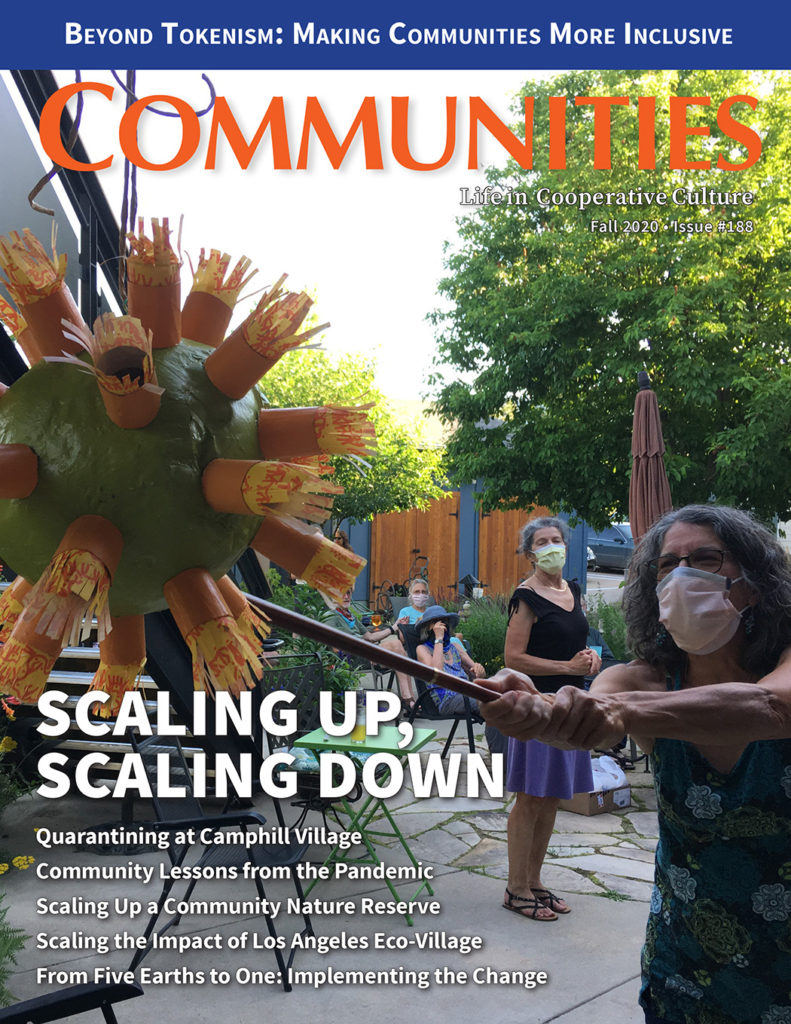
Communities #188
Fall 2020
Note: You can order a copy of this issue here.
Our Fall 2020 issue explores “scaling” from many angles. We look at cultural changes necessary for groups to scale up a more inclusive form of community; reasons to scale out, rather than up; and many replicable, practical examples of scaling down our ecological footprints. We also explore the coronavirus pandemic and its impacts on intentional communities and on the scales at which they are currently operating around the world, drawing lessons applicable both within quarantine and without.
SCALING UP, SCALING DOWN
Notes from the Editor: Up, Down, and All Around by Chris Roth
At times, scaling up is enlivening and essential. At others, scaling down is what we all need.
Notes from Our Partners: Return to Agua Caliente by Paul Freundlich
The will of a community and creative leadership can accomplish much even in the poorest of conditions; the latest “Notes in Passing” tells the story.
Views from GEN-US: How will your community celebrate the North American Day of Sustainable Communities?
Beyond Tokenism: How Your Group Can Become More Inclusive by Crystal Byrd Farmer
Increasing groups’ diversity is essential to scaling up the intentional communities movement, but individual communities often fail to attract willing “recruits” among marginalized people. Here are some likely reasons, along with guidance on changing the dynamic.
What If?—Scaling Out Regenerative Development Glocally: Building Educational Ecosystems of Collaboration to Improve Planetary Health by Daniel Christian Wahl
What if we had abundant financial resources to bring about the world we’d like to see? How would we use the funding newly flowing into restoration and regenerative development?
Nurturing Vital Diversity and Resilience: Scaling Out, rather than Scaling Up! by Daniel Christian Wahl
The way to take the design of regenerative systems to scale is by spreading patterns that work and that increase health, vitality, resilience, and adaptive capacity.
From Five Earths to One: Implementing the Change by Jan Spencer
A sustainable society will require deep downsizing, public and private, in terms of shelter, food, transportation, recreation, urban design, budgets, and employment. These examples of people doing just that offer inspiration and hope for a viable future.
Green Localist Pathways to Ecological Civilization: Scaling the Impact of Los Angeles Eco-Village by Audrey Younsook Jang
For 27 years L.A. Eco-Village has been demonstrating a compelling alternative approach to sustainable development, meeting and exceeding the climate-related goals that the State of California has failed to reach despite its well-intentioned top-down mandates.
Los Angeles Eco-Village: The Ups and Downs of Reinventing How We Live in Cities by Lois Arkin
As a community founder scales down, her organization scales up. Decades of work bear results, once-fringe ideas and practices become common, and, in a world in desperate need of repair, retrofit urban ecovillages offer hope.
Living Your Natural and Social Dream: A journey into eco-projects and intentional communities in Southern Europe by Adriano Bulla
Common among intentional communities in Spain, but still lacking in Southern Italy, mutual support systems allow the sharing not only of goods and produce, but of knowledge and experience.
Scaling Up a Community Nature Reserve by Dr. Adrian Cooper
A network of wildlife-friendly backyard gardens experiences a period of unprecedented growth, even in the midst of a pandemic, thanks to a systems-oriented approach, a dedication to inclusiveness, and an array of strategies.
Scaling to the Pandemic: Community Perspectives by Indra Waters
Surveys and interviews reveal that intentional communities all around the world have a broad range of responses to the current public health emergency, and even individual community-mates can vary widely in their views and approaches.
Lessons from the Pandemic Lockdown at the Danthonia Bruderhof, New South Wales by Bill Wiser
This pandemic is our generations’ World War equivalent, and also our chance to rebuild. Even now, in a time of lockdown, lessons are emerging—both within intentional communities and in a wider context—that may serve as signposts for the future.
Quarantining at Camphill: Distance, Warmth, and the Unknown Future by Matthew Goeztke and Diedra Heitzman
Sheltering from COVID-19, residents of Kimberton Hills ask: Will our model of a caring, ecologically conscious, income-sharing community stay healthy enough to continue to help others?
Cohousing Is a Vaccine against COVID-19 Isolation, Loneliness by Alan O’Hashi
Cohousing communities and their residents are well equipped to deal with crisis situations, such as implementing current COVID-19 prevention measures without resorting to martial law.
Community Is Everything: Upheaval and Renewal by Niánn Emerson Chase
I and my body reflect the paradox of joy and sorrow, but more joy, for I know that in spite of the Coronapocalypse and global-warming calamities that threaten so many lives, a new world will emerge in the near future.
Grasshopper Man, Driving Through by Stephen Wing
I am one cell of an unimaginably immense multicellular creature…one small part of something grand… Does that make me small or grand?
Viral Poetry for a New Age by Ron Gordon
Toilet paper pandemonium, with balloons, and more tips on staying safe.
Excerpted from the Fall 2020 edition of Communities (#188), “Scaling Up, Scaling Down” (available here or by subscribing).
